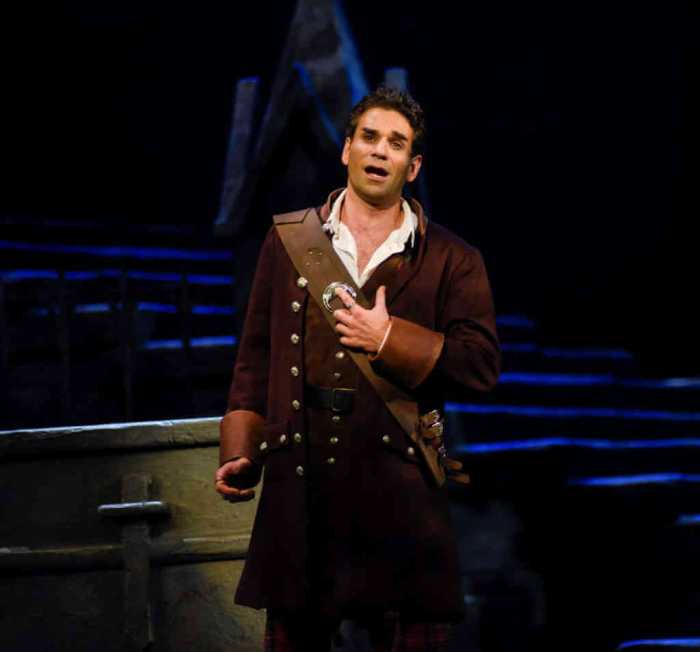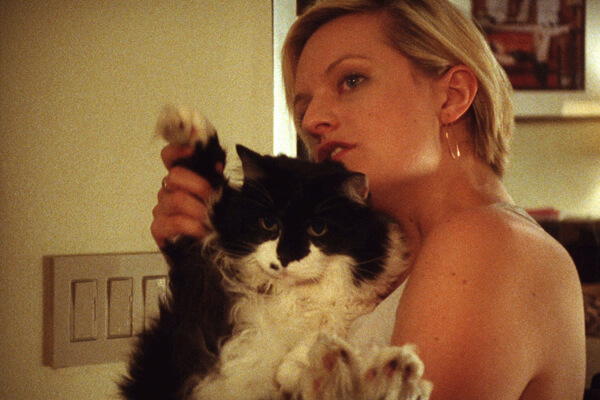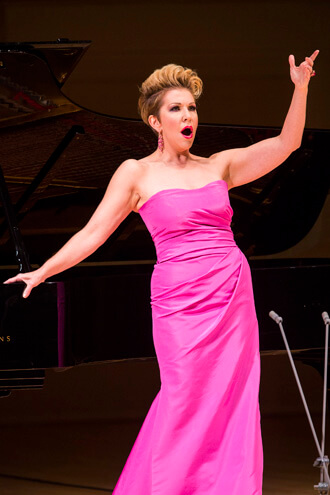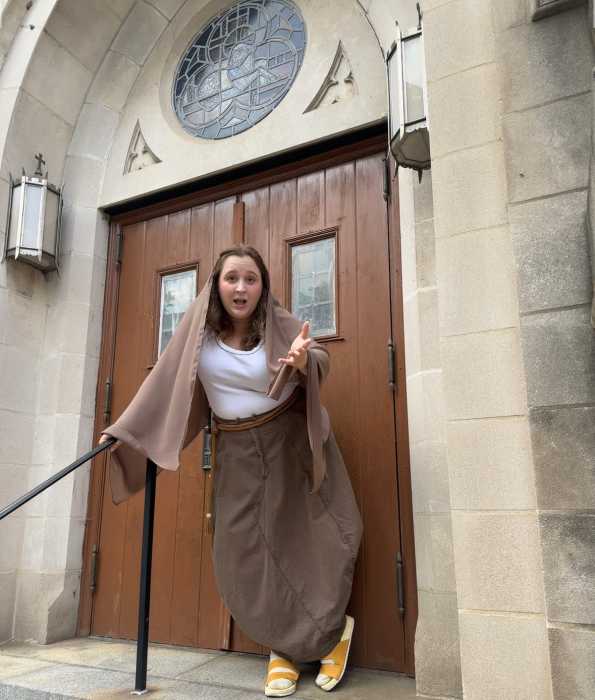Severely Mame in glitter pants and a USA flag jacket created by Claire Fleury. | ALESIA EXUM
The history of fashion is awash with the names of male gay designers, but there have been surprisingly few women couturiers who have identified as queer. There were once bisexual whispers about Coco Chanel and, recently, Jill Sander has been quite open about her lesbianism.
A couple of summers ago, I had the pleasure of meeting Claire Fleury, when, under the auspices of the Bureau of General Services — Queer Division (BGSQD), I introduced a pair of gay-related films at her Strange Loop Gallery on Ludlow Street. While the gallery is no more, Fleury has re-emerged with pop-up boutiques that feature her true passion — the clothes she designs that are joyously remindful of that fervent creative East Village period of the 1980s with their brilliant color palettes, edgy silhouettes, and effortlessly easy air of sartorial insouciance. Her creations (clairefleury.com) are at once punk rock and haute elegance.
Explaining that “every month, I will pop up in a different location,” Fleury will be at 3, a hair salon at 90 East Third Street on November 20 from 5 to 8 p.m., in collaboration with painter Timothy Atticus and stylists from 3. “It’s a different way of shopping,” said the talkative and talented drink of water. “Adventurous because of the venue, location, and combination with other artists. Personal because it’s small scale, very select items, and I am always there to style you and give advice. And cool because it is not a conventional store.”
One Dutch designer’s unique take, Diva DiDonato, NYFF Magic
Fleury first came to New York in 1991, staying for a year and working as a dancer and a bicycle messenger. She hails originally from Amsterdam where she studied dance and later performing arts. “These schools were helpful in the sense that they both promoted a creative way of thinking in almost any field,” she said. “We had experimental dinners cooked at school, played music, danced, wrote, filmed, performed. New ideas were encouraged, experiments greeted with enthusiasm. I always felt nurtured in trying out anything new that I could come up with, however silly or great those ideas were.”
Back then, her big influences “came from the UK predominantly: Michael Clark, Siouxsie and the Banshees, Vivienne Westwood, David Bowie, Boy George. But then I discovered the fashions of Jimi Hendrix, Prince, even Rod Stewart in the ‘70s. It all comes down to what is glamorous, pop, performative, colorful. The designers Galliano and Pam Hogg, throw in a Renaissance painting and some traditional wear from Holland and Japan, traditional professional wear like sailor pants, chefs’ aprons, kilts, school uniforms. I could go on and on! I guess it’s all about how you mix things up, because I believe a lot of people mix styles and inspirations, especially in fashion, and that, in turn, inspires other people, like me.”
Fleury said she identifies more with being “gay” or “queer” than “lesbian.”
Claire Fleury in a checkered suit she created. | ALESIA EXUM
“I was always different, just did not think anything of it until other kids started making comments,” she recalled. “I stayed different and I guess I started flirting with the same sex from the age of four. My mom and brother were always cool with it. My father was not and told me at age 16 that he did not agree with my lifestyle and therefore would not pay for my study, like he did for my brother. I was thus forced to work in bars and restaurants until the crack of dawn, and would take my first dance lessons in the morning half asleep [laughs].”
Fleury is married to Alesia Exum, with whom she ran Strange Loop, where BGSQD, which just moved to the LGBT Community Center on West 13th Street, had its first of several incarnations.
“They opened their book store and event space in our gallery, and organized an amazing amount of events in that space, that brought in a lot of wonderful people,” She said. “Alesia and myself continued to curate the exhibitions there. After nine months, we felt it was time to go our separate ways and the Bureau moved on.
“After a total of two and a half years, I felt it was time to move along and focus on my own artistic career. I am however forever grateful for the experience, for meeting hundreds of wonderful people. We refer to it as a ‘two-and-a-half-year durational performance.’ Dressing is a form of expression. Even if you want your clothes to say ‘no comment,’ you’ve just said something.
“I believe the meaning and expression of clothes change according to who puts them on. That is the beauty of it. Therefore I call my clothes a collaborative performance with whoever wears them. Eventually I would like to travel more, have my pop-ups in other cities and countries, while always remaining that secret party that you have to know about instead of the franchise no one wants to hear about. I have some secret famous clients that I cannot reveal, but I make custom clothes for a number of musicians. I need to move on from making pants for drummers though — no one ever gets to see them! I would love to make a suit for Laurie Anderson, a coat for David Bowie, and a kilt for Nick Cave.”
Despite my huge reluctance at returning from a glorious month in my native Hawaii, once more I realized exactly why I live in New York when I attended Joyce DiDonato’s utterly magical concert and release party for her ravishing new CD, “Stella di Napoli.” It celebrates the birth of bel canto opera in 19th century Naples, and the event took place at the Gowanus Ballroom in Brooklyn, a working metal factory by day alongside that toxic canal which, on the night of October 3, managed to look as enchanting as any in Venice. The concert was presented in collaboration with LoftOpera, one of those essential small companies that has rushed into the breach left by the sad demise of New York City Opera. It is staging “The Barber of Seville,” and offered samples, featuring wonderful Mexican baritone José Adán Pérez in the title role, who sang with such ardor, musicality, and acting élan that I am not going to miss this production for the world (loftopera.com).
The evening, however, was DiDonato’s all the way. Renee Fleming has somehow been dubbed “The People’s Diva,” but I feel this appellation suits DiDonato far more, and she proved it once more with her singular choice of this perfect, unexpected venue and the passion with which she performed and even lectured the audience — comprised of many young hipsters, obviously opera newbies — about the history and wonders of bel canto. She made this miraculous era of music-making fully come to life, and her soaring voice beautifully served the arching melodies of Bellini, Donizetti, and Rossini, as well as lesser known but quite marvelous composers like Pacini and Mercadante.
In a spirit of hospitality combining both Brooklyn and Italia, free beer was served all night, as well as pizza after the concert. Instead of being whisked away to some luxe after-soiree with millionaire patrons, DiDonato simply changed out of her gorgeous Vivienne Westwood sequined gown into a more casual sequined party shift, grabbed a brewski, and hung out all night. She told me how excited she was to be doing Handel’s “Alcina” at Carnegie Hall on October 26 (Carnegiehall.org), for which Westwood is again designing her dress, “making my character’s transformation something wonderfully reptilian!”
Anti-gay bullying is one of DiDonato’s special concerns, and she performed beautifully at last spring’s terrific “Broadway Battles Bullying” benefit at NYU and was recently filmed by PBS singing Purcell’s “Dido’s Lament” at the Stonewall Inn, “in tribute,” she said, “to victims of this kind of senseless violence which I cannot believe is happening in this day and age. (joycedidonato.com)
The New York Film Festival, after its stumble with the opening night “Gone Girl,” kicked into high gear with some far more worthy selections. Bertrand Bonello’s “Saint Laurent,” the “other” movie about the legendary French designer –– after Jalil Lespert’s “Yves Saint Laurent,” officially approved by the fashion house –– proved to be a bolder, more exhilarating work than its predecessor. Although overlong and suffering by comparison with the brilliant Pierre Niney in the title role of Lespert’s film, Bonello’s movie really caught, in a visceral way, the vital, inevitably destructive business end of things and the insanity of both the artist’s mind and his sex-and-drug-charged world. It pulled no punches in terms of nudity or graphic depictions of closed-door antics.
Olivier Assayas’ fascinating “Clouds of Sils Maria” was one of the best depictions ever made of how a woman functions as both actress and star. Juliette Binoche, as the aging star, Kristen Stewart, as her intense young assistant, and Chloë Grace Moretz, as something of an Eve Harrington character, each gave their greatest performances to date, while providing one hell of an ensemble to boot. At the press conference, Assayas mentioned how Binoche originally suggested this gift of a women’s project and how he’d originally imagined Stewart in the Moretz role. Binoche expressed her deep admiration for Stewart, admitting even to being intimidated by her gifts. Allowed to be a human being on film for once, finally matching her beauty with real talent here, Stewart graciously talked about how blown away she was to act in such company.
But it was Alex Ross Perry’s “Listen Up Philip” that crowned the fest for me, a really brilliant portrait of the artist as one impossible young man. Jason Schwartzman plays the title role, a horrendously misanthropic and narcissistic writer for whom life is a complete impossibility, meeting up with his perfect, older, and equally reprehensible alter ego in the person of Jonathan Pryce, as an eminent author obviously based on Philip Roth.
Perry’s wonderful, insanely literate dialogue –– organically awash with five-dollar words –– coupled with his bold visual sense and deep human empathy resulted in that rarity of rarities: a truly intelligent film that makes you think just as effectively as any great, lofty European auteur has ever managed to do. A divine selection of sexy, smart, emotionally deep women –– Elisabeth Moss, Joséphine de La Baume, Krysten Ritter –– add their potently pulsating presence to a work that recalls the cinema’s Golden Age, when just as important as seeing a film was to feverishly discuss it afterwards.
Contact Noh at Inthenoh@aol.com and check out his blog at http://nohway.wordpress.com.




































